Mountfield 2248 H, 1540, 2040 H, 1840 H user Manual
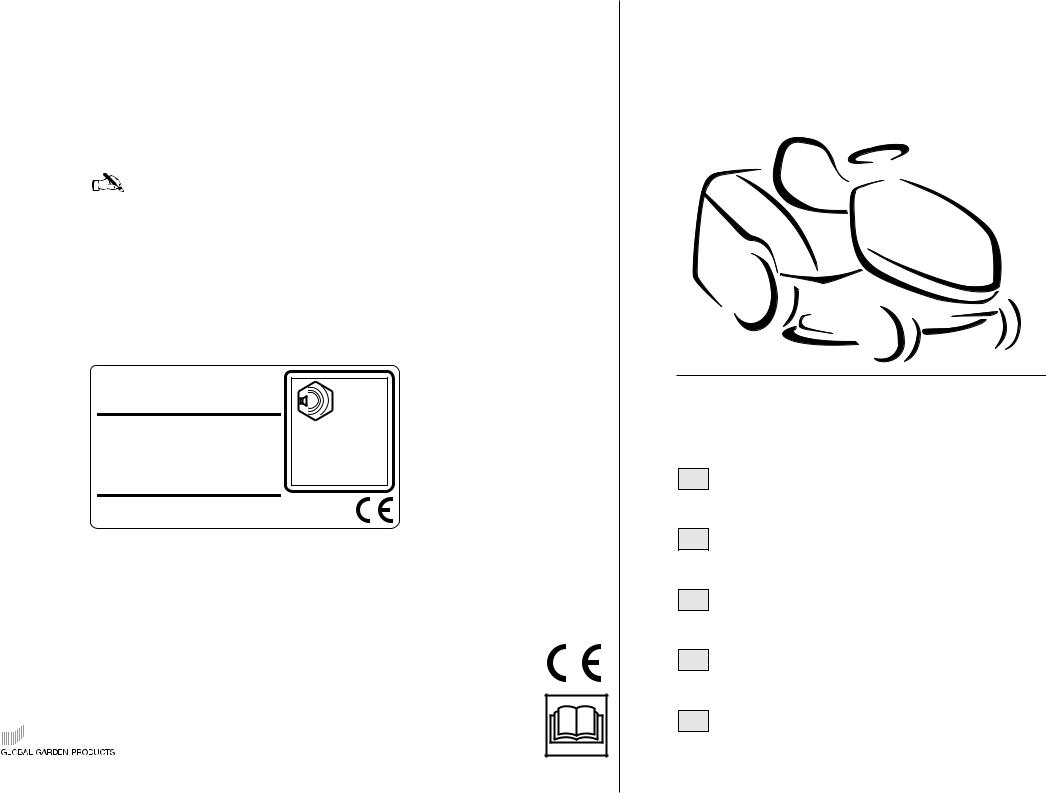
•Tout de suite après l’achat, transcrire dans les espaces prévus les
données d’identification (3 – 5 – 6) qui sont indiquées sur l’étiquette d’identification de la machine ( 2.1 - IDENTIFICATION DE LA MACHINE).
•As soon as you have purchased the machine, write the machine
identification data (3 - 5 - 6) found on the identification label in the spaces provided ( 2.1 - IDENTIFICATION OF THE MACHINE).
•Tragen Sie sofort nach dem Kauf die Kennnummern (3 - 5 - 6) in die entsprechenden Felder auf dem Kennungsschild der Maschine ein ( 2.1 - KENNZEICHNUNG DER MASCHINE).
•Immediatamente dopo l’acquisto, trascrivere negli appositi spazi i dati di
identificazione (3 - 5 - 6) riportati sull’etichetta di identificazione della macchina ( 2.1 - IDENTIFICAZIONE DELLA MACCHINA).
•Onmiddellijk na aankoop worden de identificatiegegevens (3 - 5 - 6) genoteerd in de ruimten op het identificatielabel van de machine ( 2.1 - IDENTIFICATIE VAN DE MACHINE).
LWA
Model: . . . . . . . . . . . . . . . .
dB
Year . . . . . . . S/N° . . . . . . . . . . . . . . . .
GGP ITALY SPA
Via del Lavoro, 6
I-31033 Castelfranco Veneto (TV) ITALY
© by GGP ITALY
Realizzazione: EDIPROM / bergamo
71505175/1
102-122
FR TONDEUSE AUTOPORTÉE
MANUEL D’UTILISATION
ATTENTION! - Avant d’utiliser la machine, lire attentivement le présent manuel.
EN LAWN-TRACTOR
OWNER’S MANUAL
WARNING!
Read this manual carefully before using the machine.
DE RASENTRAKTORGEBRAUCHSANWEISUNG
ACHTUNG! - Bevor man die Maschine verwendet lese man das vorliegende Handbuch sorgfältig durch.
IT TRATTORINO RASAERBA
MANUALE DI ISTRUZIONI
ATTENZIONE: prima di utilizzare la macchina, leggere attentamente il presente manuale.
NL ZITMAAIERGEBRUIKERSHANDLEIDING
LET OP! – Vooraleer de machine te gebruiken, lees aandachtig deze handleiding.

INTRODUCTION |
EN |
1 |
INTRODUCTION
Dear Customer,
thank you for having chosen one of our products. We hope that you will get complete satisfaction from using your new lawn-tractor and that it will fully meet all your expectations.
This manual has been compiled in order that you may get to know your machine and to be able to use it safely and efficiently. Don’t forget that it forms an integral part of the machine, so keep it handy so that it can be consulted at any time, and pass it on to the purchaser if you resell the machine.
This new machine of yours has been designed and made in line with current regulations, and is safe and reliable if used for cutting and collecting grass exactly following the instructions given in this manual (proper usage). Using the machine in any other way or ignoring the instructions for safe usage, maintenance and repair is considered "incorrect usage" which will invalidate the guarantee, and the manufacturer will decline all responsibility, placing the blame with the user for damage or injury to himself or others in such cases.
Since the product is continually being improved, you may find slight differences between your machine and the descriptions contained in this manual. Certain modifications can be made to the machine without prior warning and without the obligation to update the manual, although the essential safety and function characteristics will remain unaltered. In case of any doubts, do not hesitate to contact your Retailer. And now enjoy your work!
AFTER-SALES SERVICE
This manual gives all the necessary instructions for using the machine and the basic maintenance that may be carried out by the user.
Any adjustments or maintenance operations not described in this manual must be carried out by your Dealer or a specialized Service Centre. Both have the necessary knowledge and equipment to ensure that the work is done correctly without affecting the safety of the machine.
If you wish, your Reitailer will be pleased to offer a maintenance programme personalised to your needs. Like this you will be able to keep your new acquisition in peak performance, maintaining its value.
2 |
|
EN |
|
TABLE OF CONTENTS |
TABLE OF CONTENTS |
|
|||
1. |
SAFETY ..................................................................................................................... |
3 |
||
|
Regulations for using the machine safely |
|
||
2. |
IDENTIFICATION OF THE MACHINE AND COMPONENTS ................................. |
7 |
||
|
Explanations on how to identify the machine and its main components |
|||
3. |
UNPACKING AND ASSEMBLY ............................................................................... |
9 |
||
|
Explanations on how to remove the packing and on how to assemble |
|||
|
separated parts |
|
||
4. |
CONTROLS AND INSTRUMENTS ........................................................................ |
13 |
||
|
Position and functions of all the controls |
|
||
5. |
HOW TO USE THE MACHINE ............................................................................... |
21 |
||
|
Provides indications for working efficiently and safely |
|
||
|
5.1 |
Safety recommendations ................................................................................. |
21 |
|
|
5.2 |
Why the safety devices cut in .......................................................................... |
21 |
|
|
5.3 |
Preliminary operations before starting work ..................................................... |
22 |
|
|
5.4 |
Using the machine .......................................................................................... |
24 |
|
|
5.5 |
Using on slopes ............................................................................................... |
32 |
|
|
5.6 |
Transporting ..................................................................................................... |
33 |
|
|
5.7 |
Lawn maintenance .......................................................................................... |
33 |
|
6. |
MAINTENANCE ..................................................................................................... |
35 |
||
|
All the information for maintaining the machine in peak efficiency |
|||
|
6.1 |
Safety recommendations ................................................................................. |
35 |
|
|
6.2 |
Routine maintenance ....................................................................................... |
35 |
|
|
6.3 |
Checks and adjustments ................................................................................. |
38 |
|
|
6.4 |
Dismantling and renewing parts ...................................................................... |
39 |
|
|
6.5 |
Information for Service Centres ..................................................................... |
41 |
|
7. |
TROUBLESHOOTING ............................................................................................ |
43 |
||
|
A help in quickly resolving any problems |
|
||
8. |
ACCESSORIES ON REQUEST ............................................................................. |
46 |
||
|
A description of the accessories available for particular types of work |
|||
9. |
SPECIFICATIONS .................................................................................................. |
47 |
||
|
A summary of the main specifications of your machine |
|
||
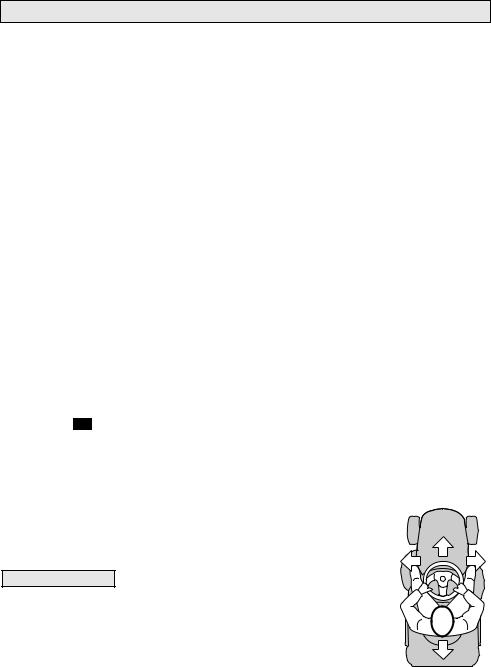
SAFETY |
EN |
3 |
1.SAFETY
1.1HOW TO READ THE MANUAL
Some paragraphs in the manual containing information of particular importance for safety and operation are highlighted at various levels of emphasis, and signify the following:
|
NOTE |
or |
IMPORTANT |
These give details or further information |
on what has already been said, and aim to prevent damage to the machine. |
||||
|
|
|
|
|
! |
WARNING! |
Non-observance will result in the risk of injury to oneself or |
||
|
|
|||
others. |
|
|
|
|
|
|
|
|
|
! |
DANGER! |
Non-observance will result in the risk of serious injury or |
||
|
|
|||
death to oneself or others.
This manual describes various versions of the machine, which mainly differ in:
–type of transmission: with mechanical gear-change or with hydrostatic continuous speed adjustment. The models with hydrostatic transmission can be recognised by the word "HYDRO" on the identification label ( 2.1);
–the inclusion of components or accessories which may not be available in some areas;
–special equipments fitted.
The symbol highlights all differences in usage and is followed by the indication of the version to which it refers.
The symbol “ ” makes a reference to another part of the manual where further information or clarification can be found.
NOTE |
Whenever a reference is made to a position on |
the machine “front”, “back”, “left” or “right” hand side, this is determined by facing the direction of forward travel.
IMPORTANT For all operations regarding the use and maintenance of the engine or the battery not described in this manual, refer to the relevant manuals which form an integral part of all the documentation supplied with the machine.

4 |
EN |
SAFETY |
1.2 SAFETY REGULATIONS
! WARNING! Read carefully before using the machine.
A) TRAINING
1)Read the instructions carefully. Be familiar with the controls and the proper use of the equipment.
2)Never allow children or people unfamiliar with these instructions to use the lawnmower. Local regulations can restrict the age of the operator.
3)Never mow while people, especially children, or pets are nearby.
4)Keep in mind that the operator or user is responsible for accidents or hazards occurring to other people or their property.
5)Do not carry passengers.
6)All drivers should seek and obtain professional and practical instruction. Such instruction should emphasise:
– the need for care and concentration when working with ride-on machines;
– control of a ride-on machine sliding on a slope will not be regained by the application of the brake. The main reasons for loss of control are:
–insufficient wheel grip;
–being driven too fast;
–inadequate braking;
–the type of machine is unsuitable for its task;
–lack of awareness of the effect of ground conditions, especially slopes;
–incorrect hitching and load distribution.
B) PREPARATION
1) While mowing, always wear substantial footwear and long trousers. Do
not operate the equipment when barefoot or wearing open sandals.
2)Thoroughly inspect the area where the equipment is to be used and remove all objects which can be thrown by the machine.
3)DANGER! Petrol is highly flammable:
– store fuel in containers specifically designed for this purpose;
– refuel outdoors only and do not smoke while refuelling;
– add fuel before starting the engine.
Never remove the cap of the fuel tank or add petrol while the engine is running or when the engine is hot;
– If petrol is spilled, do not attempt to start the engine but move the machine away from the area of spillage and avoid creating any source of ignition until the petrol vapours have dissipated;
– replace all fuel tank and container caps securely.
4)Replace faulty silencers.
5)Before using, always visually inspect to see that the blades, blade bolts and cutter assembly are not worn or damaged. Replace worn or damaged blades and bolts in sets to preserve balance.
6)On multi-bladed machines, take care as rotating one blade can cause other blades to rotate.
C) OPERATION
1)Do not operate the engine in a confined space where dangerous carbon monoxide fumes can collect.
2)Mow only in daylight or good artificial light.
3)Before attempting to start the engine, disengage all blade attachment clutches and shift into neutral.
4)Do not use on slopes of more than 10° (17%).
SAFETY |
EN |
5 |
5)Remember there is no such thing as a “safe” slope. Travel on grass slopes requires particular care. To guard against overturning:
– do not stop or start suddenly when going up or downhill;
– engage the clutch slowly and always keep the machine in gear, especially when travelling downhill;
– machine speeds should be kept low on slopes and during tight turns;
– stay alert for humps and hollows and other hidden hazards;
– never mow across the face of the slope.
6)Use care when pulling loads or using heavy equipment:
– use only approved drawbar hitch points;
– limit loads to those you can safely control;
– do not turn sharply. Use care when reversing;
– use counterweight(s) or wheel weights when suggested in the instruction handbook.
7)Stop the blades rotating before crossing surfaces other than grass.
8)Never operate the machine with defective guards, or without safety protective devices in place.
9)Do not change the engine governor settings or overspeed the engine. Operating the engine at excessive speed can increase the hazard of personal injury.
10)Before leaving the operator’s position:
– disengage the power take-off and lower the attachments;
– change into neutral and set the parking brake;
– stop the engine and remove the key.
11)Disengage drive to attachments, stop the engine and remove the ignition key:
– before clearing blockages or unclogging chutes;
–before cleaning, checking or working on the machine;
–after striking a foreign object. Inspect the machine for damage and make repairs before restarting and operating the equipment;
–If the machine starts to vibrate abnormally (check immediately).
12) Disengage drive to blades when transporting or not in use.
13) Stop the engine and disengage drive to the attachment:
–before refuelling;
–before removing the grass catcher. 14) Reduce the throttle setting during engine run-out and, if the engine is provided with a shut-off valve, turn the fuel off at the conclusion of mowing.
D) MAINTENANCE AND STORAGE
1)Keep all nuts, bolts and screws tight to be sure the equipment is in safe working condition.
2)Never store the equipment with petrol in the tank inside a building where fumes may reach an open flame or spark.
3)Allow the engine to cool before storing in any enclosure.
4)To reduce the fire hazard, keep the engine, silencer, battery compartment and petrol storage area free of grass, leaves, or excessive grease.
5)Check the grass catcher frequently for wear or deterioration.
6)Replace worn or damaged parts for safety.
7)If the fuel tank has to be drained, this should be done outdoors.
8)On multi-bladed machines, take care as rotating one blade can cause other blades to rotate.
9)When the machine is to be stored or left unattended, lower the cutting deck.
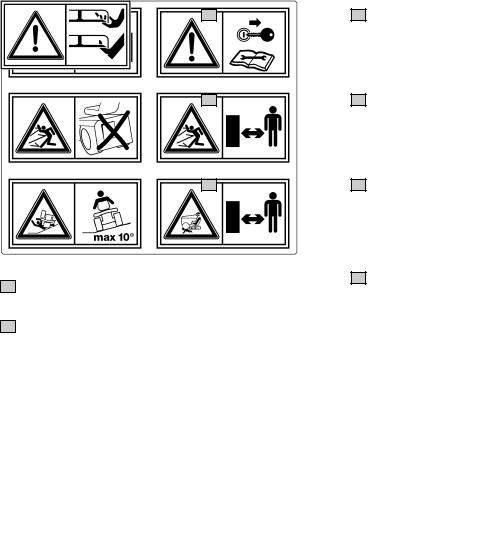
6 |
EN |
SAFETY |
1.3 SAFETY DECALS
Your machine must be used with care. Therefore, decals have been placed on the machine, to remind you pictorially of the main precautions to take during use. These decals are to be considered an integral part of the machine.
If a decal should fall off or become illegible, contact your Retailer to replace it. Their meaning is explained below.
1Warning: Read the Operator’s Manual before operating this machine.
2Warning: Disconnect the ignition key and read the instructions before carrying out any repair or maintenance work.
3Danger! Ejected objects: Do not operate without either the stone-guard or grass-catcher in place.
4Danger! Ejected objects:
Keep bystanders away.
5Danger! Machine rollover: Do not use this machine on slopes greater then 10°.10°.
1
3
5
2
4
6
7
6Danger! Dismembetment: Make sure that children stay clear of the machine all the time when engine is running.
7Danger of cutting yourself. Blades in movement. Do not put hands or feet near or under the opening of the cutting plate.
1.4 REGULATIONS FOR TOWING
A kit for towing a small trailer is available on request.
This accessory is to be fitted as per the instructions provided. When using, do not exceed the recommended drawbar loads stated on the decal and follow the safety instructions, ( 1.2, C-6).
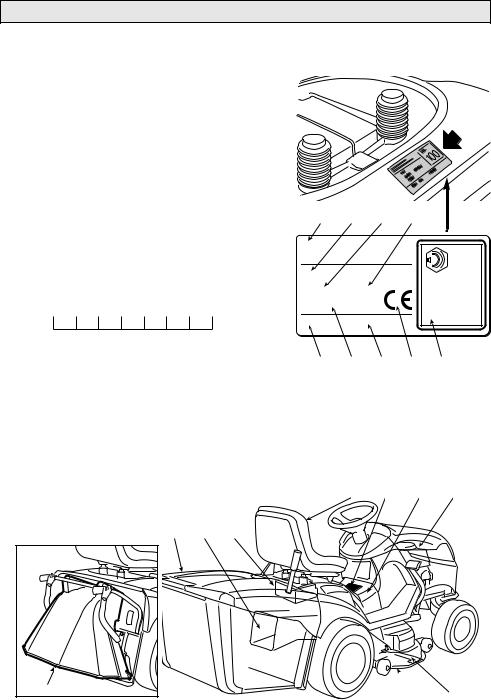
IDENTIFICATION OF THE MACHINE AND COMPONENTS |
EN |
7 |
2.IDENTIFICATION OF THE MACHINE AND COMPONENTS
2.1IDENTIFICATION OF THE MACHINE
The plate located near the battery housing has the essential data of each machine.
1.Acoustic power level according to directive 2000/14/CE
2.Conformity mark according to directive 98/37/EEC
3.Year of manufacture
4.Operating engine speed in r.p.m (if indicated)
5.Type of machine
6.Serial number
7.Weight in kg
8.Name and address of Manufacturer
9.Type of transmission (if indicated)
Write your machine’s serial number here (6)
2.2 IDENTIFICATION OF MAIN COMPONENTS
8 |
5 |
4 |
7 |
|
|
|
|
|
LWA |
min-1 |
kg |
|
|
|
|
S/N |
|
|
dB |
|
|
|
|
|
3 |
9 |
6 |
2 |
1 |
Various main components can be seen on the machine, and these have the following functions:
11. Cutting deck: this is the guard enclosing the rotating blades.
18 |
19 |
20 |
16 |
15 |
14 13 17
 11 12
11 12
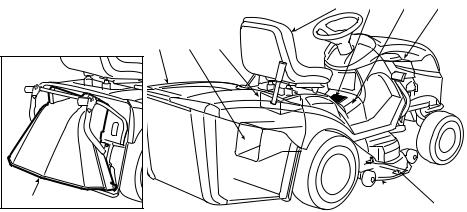
8 |
EN |
IDENTIFICATION OF THE MACHINE AND COMPONENTS |
14 13 17
15 |
18 |
19 |
20 |
16 |
 11 12
11 12
12.Blades: these are what cut the grass. The wings at the ends help convey the cut grass towards the collector channel.
13.Collector channel: this is the part connecting the cutting deck to the grasscatcher.
14.Grass-catcher: as well as collecting the grass cuttings, this is also a safety element in that it stops any objects drawn up by the blades from being thrown outside of the machine.
15.Stone-guard or deflector (available as optional part): this can be fitted in place of the grass-catcher and prevents objects drawn up by the blades from being thrown outside of the machine.
16.Engine: this moves the blades and drives the wheels. Its specifications and regulations for use are described in a specific manual.
17.Battery: provides the energy for starting the engine. Its specifications and regulations for use are described in a specific manual.
18.Driver seat: this is where the machine operator sits. It has a sensor for detecting the presence of the operator which is a safety device.
19.Decals for regulations and safety: give reminders on the main provisions for working safely, each of which is explained in chapter 1.
20.Inspection hatch: for access to make several adjustments.
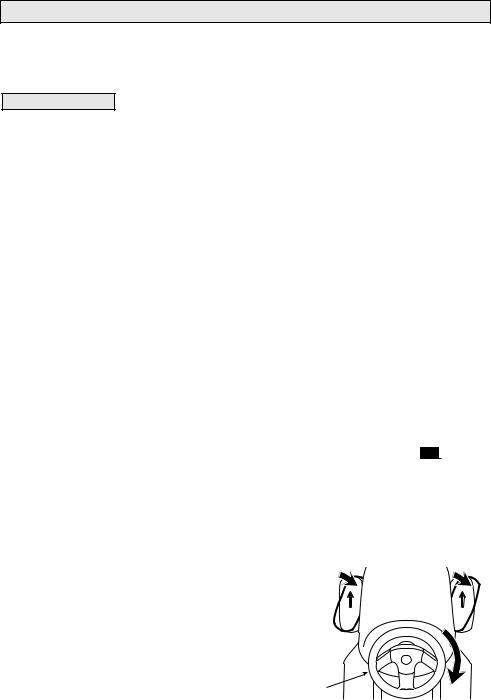
UNPACKING AND ASSEMBLY |
EN |
9 |
3. UNPACKING AND ASSEMBLY
For storage and transport reasons, some components of the machine are not directly installed in the factory, but have to be assembled after their removal from the packing. Final assembly is carried out by following these simple instructions.
IMPORTANT The machine is supplied without engine oil or fuel. Before starting up the engine, fill with oil and fuel following the instructions given in the engine manual.
3.1 UNPACKING
When unpacking the machine, take care to gather all individual parts and fittings, and do not damage the cutting deck when taking the machine off the base pallet.
The packing contents:
–the machine;
–the battery;
–the steering wheel;
–the seat;
–the grass-catcher brackets;
–the grass-catcher components;
–an envelope containing:
–the operator’s manuals and documents,
–the nuts and bolts including a pin for blocking the steering wheel,
–2 starter keys and a spare 10 A fuse.
NOTE |
To prevent damaging the cutting deck when getting the machine |
down from the pallet, take it to the maximum height and be very careful. For
hydrostatic drive models: to make it easier to get the machine off the pallet and to move it, the drive disengage lever should be put in position «B» ( 4.33).
3.2 FITTING THE STEERING WHEEL |
|
Put the machine on a flat surface and straighten up |
|
the front wheels. Fit the steering wheel (1) onto the |
|
protruding shaft (2) so that the spokes are correctly |
|
lined up. |
|
Move the front wheels to turn both the shaft (2) and |
|
the steering wheel (1) about a quarter of a turn in |
|
order to get to the hole (3) on the shaft. |
1 |
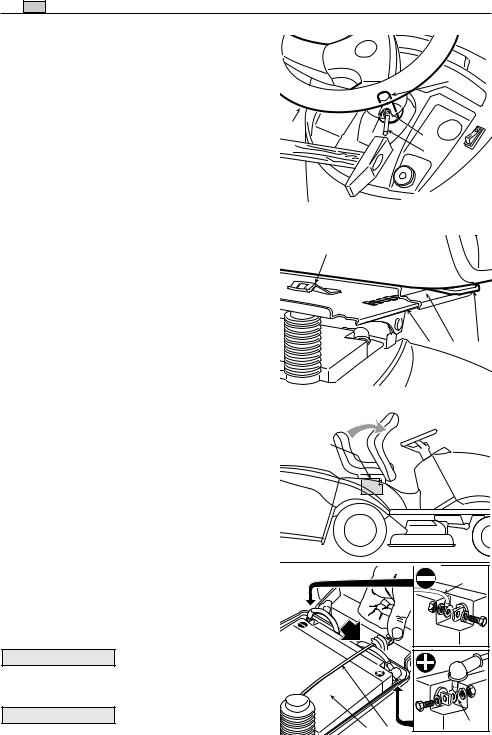
10 EN |
UNPACKING AND ASSEMBLY |
Line up the hole on the steering wheel hub (4) |
|
|
with the hole on the shaft (3) and insert the pin |
|
|
supplied (5) using a hammer, ensuring that the |
2 |
|
end comes completely through to the opposite |
||
|
||
side. |
|
NOTE |
To avoid damaging the |
|
steering wheel, use a punch or a screw-driver of the same size as the pin when hammering it in the last part
1 |
|
4 |
3 |
|
5 |
3.3 FITTING THE SEAT |
4 |
|
|
|
|
|
|
Raise the adjustment lever (3) and fit the seat |
|
|
|
(1) in the slide (2), introducing it from the steer- |
|
|
|
ing wheel’s side, till the seat engages in one of |
|
|
|
the 6 positions. |
|
|
|
At this point the seat is engaged and cannot be |
2 |
1 |
3 |
|
|
|
|
completely removed unless the lever (4) is |
|
|
|
pressed, freeing it from its retainer |
|
|
|
3.4 ASSEMBLY AND CONNECTING THE |
1 |
BATTERY |
|
Position the battery (1) in its compartment under the seat.
Connect the red cable (2) to the positive termi- |
|
|
|
nal (+) and the black cable (3) to the negative |
|
|
|
terminal (–) using the supplied screws and fol- |
|
|
|
lowing the illustrated sequence. |
|
3 |
|
Fit the spring (4) to hold the battery in place |
|
||
|
|
||
and make sure all the wires are in front of the |
|
|
|
battery so that they don’t get caught in the |
|
|
|
spring (4). |
|
|
|
IMPORTANT |
Always fully charge the |
|
|
battery according to the instructions in the |
|
|
|
battery’s manual ( 6.2.5). |
|
|
|
IMPORTANT |
To prevent the safety |
1 |
2 |
|
|
||
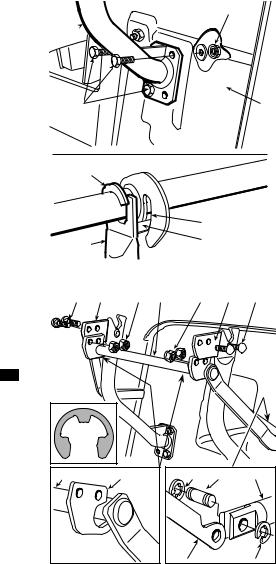
UNPACKING AND ASSEMBLY |
EN |
11 |
device in the electronics card from cutting in, never start the engine until the battery is fully charged!
! |
WARNING! |
|
|
|
Follow the battery manufacturer's instructions regarding |
|
|
safe handling and disposal.
3.5GRASS-CATCHER SUPPORT ASSEMBLY
Fit the two brackets (1) on the rear plate (2), using for each bracket three screws (3) which are supplied, as shown, without fully tightening the nuts (4).
Attach the grass-catcher to the brackets and centre it with the rear plate (2). Adjust the position of the two brackets (1) to the stop
(5) so that, when turning the grass-catcher frame, the pin (6) slots into the seat (7) correctly.
Having checked that the grass-catcher rotates as above, tighten the fixing nuts (4) securely.
4
1 
3 |
2 |
|
5 |
|
|
|
|
|
|
|
|
|
7 |
|
|
|
1 |
|
|
6 |
|
|
|
|
|
|
|
|
|
4 |
3 |
4 |
1 |
4 |
3 |
4 |
3.6ASSEMBLING THE LEVERS FOR TIP PING THE GRASS-CATCHER ( In electric lifting models)
Position the lever axle (1) in the notch of the two plates (2) and attach them on the internal side of the grass-catcher supports (3), using the included screws (4) in the sequence shown.
Connect the end of the rod (5) of the lifting piston to the lever (6) with the pin (7) and attach the two snap rings (8).
8 (x 2)
1 |
2 |
8 |
7 |
5 |
6 |
|
8 |

12 |
EN |
UNPACKING AND ASSEMBLY |
Before attaching the grass-catcher to its supports, make sure that the tipping lever moves properly.
3.7REMOVAL OF THE STOP FROM THE HOOKING PAWL OF THE GRASSCATCHER
For transport purposes, the pawl (1) hooking the grass-catcher is held 1 onto the rear plate by a stop (2).
 2
2
This stop must be removed before fitting the grass-catcher brackets, and is not to be subsequently used.
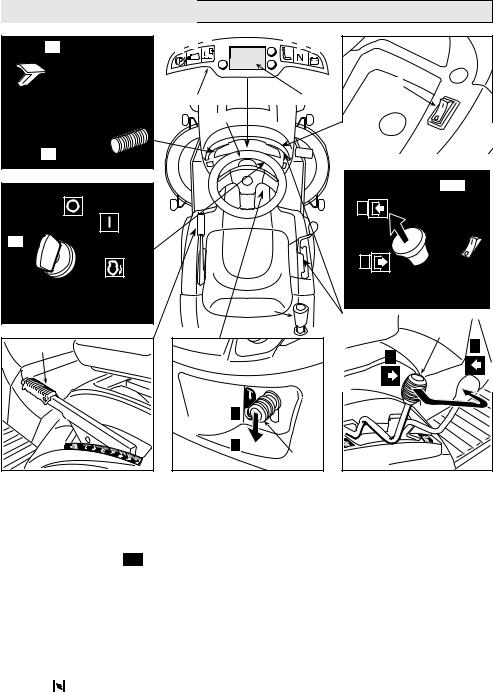
CONTROLS AND INSTRUMENTS |
EN |
13 |
4. CONTROLS AND INSTRUMENTS
4.2 |
a b c |
d e f |
|
4.10 |
4.6 |
|
4.11 |
|
|
|
4.1 |
4.3 
|
|
4.7.2 |
|
|
B |
4.4 |
|
|
|
|
A |
|
|
4.11 |
|
|
4.7.1 |
4.8 |
|
B |
|
|
A |
|
A |
|
|
B |
4.5 |
|
|
4.1STEERING WHEEL
Turns the front wheels.
4.2CHOKE CONTROL ( if fitted)
This enriches the mixture so must only be used for the time necessary when starting from cold.
4.3 ACCELERATOR LEVER
Regulates the engine's r.p.m. The positions are indicated on a plate showing the following symbols:
«CHOKE» |
( |
|
if fitted) for starting from cold |
|
|||
|
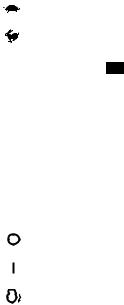
14 |
EN |
CONTROLS AND INSTRUMENTS |
«SLOW» |
for minimum engine speed |
«FAST» |
for maximum engine speed |
–The «CHOKE» position ( if fitted instead of the 4.2 control) enriches the mixture so must only be used for the time necessary when starting from cold.
–When moving from one area to another, put the lever in a position between «SLOW» and «FAST».
–When cutting, go to the «FAST» position.
4.4 KEY IGNITION SWITCH
This key operated control has three positions:
«OFF» |
everything is switched off; |
«ON» |
activates all parts; |
«START» |
engages the starter motor. |
On being released at the «START» position, the key will automatically return to «ON».
4.5 PARKING BRAKE LEVER
This lever is to stop the machine from moving when it has been parked. There are two positions:
«A»
«B»
–The brake is engaged by fully pressing the pedal (4.21 or 4.31) and moving the lever to position «B». When you take your foot off the pedal it will be blocked by the lever in the down position.
–A pilot lamp will warn that the brake is engaged (4.10.a).
–To disengage the parking brake, press the pedal (4.21 or 4.31). The lever will return to position «A».
4.6 LIGHT SWITCH
For turning on the lights when the key (4.4) is in the «ON» position.
